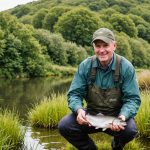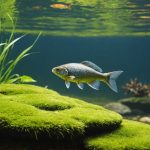Understanding Fish Populations and Ecosystems
To fully appreciate the significance of fish populations, one must first consider their pivotal role in maintaining ecological balance within aquatic ecosystems. Healthy fish populations are vital, as they contribute to nutrient cycling, support biodiversity, and provide food sources for other animals and humans alike.
In the UK, diverse local fish species such as salmon, cod, and trout play a crucial role in their respective ecosystems. Their conservation status varies widely, with some species thriving and others facing significant threats. Conservation efforts aim to prevent further declines, focusing on habitat restoration and sustainable fishing practices.
A lire en complément : Guardians of the sea: the uk”s innovative efforts to safeguard seabirds from plastic pollution
Overfishing and habitat destruction are the two primary adversaries of these populations. Overfishing depletes fish stocks faster than they can replenish, leading to imbalances in the ecosystem. Many habitats suffer from pollution, urban development, and climate change, all contributing to further declines in fish populations.
Addressing these challenges requires a multifaceted approach. Sustainable fishing methods, legal frameworks, and habitat conservation initiatives are essential to protect UK’s fish species and their ecosystems. By understanding and valuing these fish populations, society can work toward a balanced and thriving aquatic environment.
A lire également : Top fish varieties for uk ponds: boost your local ecosystem with these ideal selections
Responsible Fishing Techniques
Delving into sustainable fishing practices enhances our angling efforts while safeguarding the precious ecosystems we rely upon. Adopting responsible practices like catch and release ensures that fish populations remain healthy for future generations. But how do you minimise harm during catch and release?
Firstly, using barbless hooks significantly reduces injury, allowing fish to be released with minimal harm. It’s vital to handle fish with wet hands or a wet cloth to protect their delicate slime coating. Each step we take in the catch and release process should have minimal impact on the fish’s well-being.
Ethical angling goes hand in hand with selecting the right tackle and gear. Choosing equipment that suits the species can prevent unnecessary injury. For example, using the appropriate strength of line and a suitable rod ensures a swift and efficient catch, minimizing stress for the fish.
Moreover, techniques for reducing bycatch are essential in protecting non-target species. Ensuring that fishing spots are chosen with thought and employing devices like circle hooks can significantly decrease the unintended capture of other species, fortifying our dedication to sustainable fishing practices.
Regulations and Guidelines for UK Anglers
Understanding the fishing regulations in the UK is crucial for any angler. These rules ensure that fishing remains sustainable and environmentally friendly. At the heart of these regulations are the seasonal restrictions and catch limits. They help prevent overfishing and ensure fish populations remain healthy.
In the UK, many fish species are protected by specific times when they can be caught. These seasonal restrictions are vital for protecting fish during their breeding seasons. Abiding by these periods ensures that fish have the opportunity to reproduce and maintain their populations.
Catch limits are equally important. They dictate the maximum number of fish an angler can catch per day. This helps in preserving fish populations for future generations. Exceeding these limits can have drastic effects, disrupting the ecosystem balance.
Local guidelines play a significant role in the application of these rules. Different areas may have specific regulations tailored to their unique ecosystems. These local guidelines ensure fishing practices align with conservation goals, ultimately contributing to sustainable efforts. By following these guidelines, anglers support the long-term health of aquatic environments and ensure that waterways remain vibrant and productive.
Case Studies in Sustainable Fishing
Exploring successful conservation efforts in fishing reveals intriguing examples where communities have led impactful projects. In various regions, initiatives driven by local populations have rejuvenated aquatic ecosystems while balancing livelihoods. For example, some case studies from coastal villages in the UK exemplify how collective action can make a marked difference. Individuals within these communities have implemented strategies aimed at controlling fish harvests and promoting biodiversity.
Community initiatives often focus on sustainable practices like creating marine protected areas or regulating fishing seasons. By engaging directly with local authorities, communities ensure commitment to these conservation practices, resulting in improved fish stock and diversity. This approach has demonstrated significant benefits, not just ecologically, but also economically.
Across the globe, numerous examples illustrate the tangible impact of local fishing initiatives on fish populations. In Australia and Costa Rica, similar projects have stabilised overfished species by adjusting their protective measures accordingly. These endeavours highlight the potential ripple effects when communities work together to safeguard their natural resources.
From these cases, valuable lessons emerge: cooperation, local adaptation of strategies, and education are critical components for success. Emphasising these lessons ensures that conservation efforts continue to evolve and bolster marine environments sustainably.
Engaging in Conservation Efforts
Efforts in conservation play a crucial role in sustaining the delicate balance of aquatic ecosystems. UK anglers can actively participate in local conservation initiatives by joining community clean-up projects, which not only enhance the environment but foster a sense of camaraderie and responsibility. These projects often include removing debris from fishing areas and restoring habitats for endangered species.
Community involvement extends to supporting policies that promote sustainable fishing. Advocacy is vital here, as it influences legislation that safeguards fish populations. Anglers can contribute by engaging with campaigns that highlight the importance of catch-and-release practices and educate others on the impact of overfishing.
Collaboration with organizations dedicated to protecting fish populations presents another avenue for involvement. Many of these groups focus on research and conservation strategies, often requiring the insights and participation of local anglers. By sharing knowledge and resources, both anglers and organizations can work towards achieving more effective conservation efforts.
Through sizable contributions in advocacy and partnerships, anglers not only ensure the future of fishing but also help preserve the natural environment for future generations. These actions foster an ethos of conservation, demonstrating the profound impact of collective efforts in maintaining the vitality of aquatic life.
Educational Resources and Expert Insights
Exploring educational resources is paramount for anglers who aspire to practice sustainable fishing. Many organisations and websites offer comprehensive guides, courses, and workshops that delve into the principles of conservation and best practices in angling. These resources provide vital information on diverse topics, like fish habitats and ecosystems, which are crucial for understanding the impact of fishing activities on the environment.
Expert advice plays a critical role in guiding anglers toward more sustainable practices. Experts often stress the importance of monitoring fish populations to ensure fish species are not overexploited, thus maintaining a balance in aquatic ecosystems. Through detailed case studies and real-world examples, experts illustrate successful conservation efforts and innovative techniques that protect fish populations.
Another key aspect is the importance of continuous learning and adaptation within angling practices. The dynamic nature of ecosystems requires anglers to regularly update their knowledge and assess their methods to align with the latest environmental research and technologies. Adaptive practices, informed by up-to-date education and expert insights, enable anglers to reduce their ecological footprint while enjoying their sport. This approach not only benefits the environment but also secures the future of angling for generations to come.











